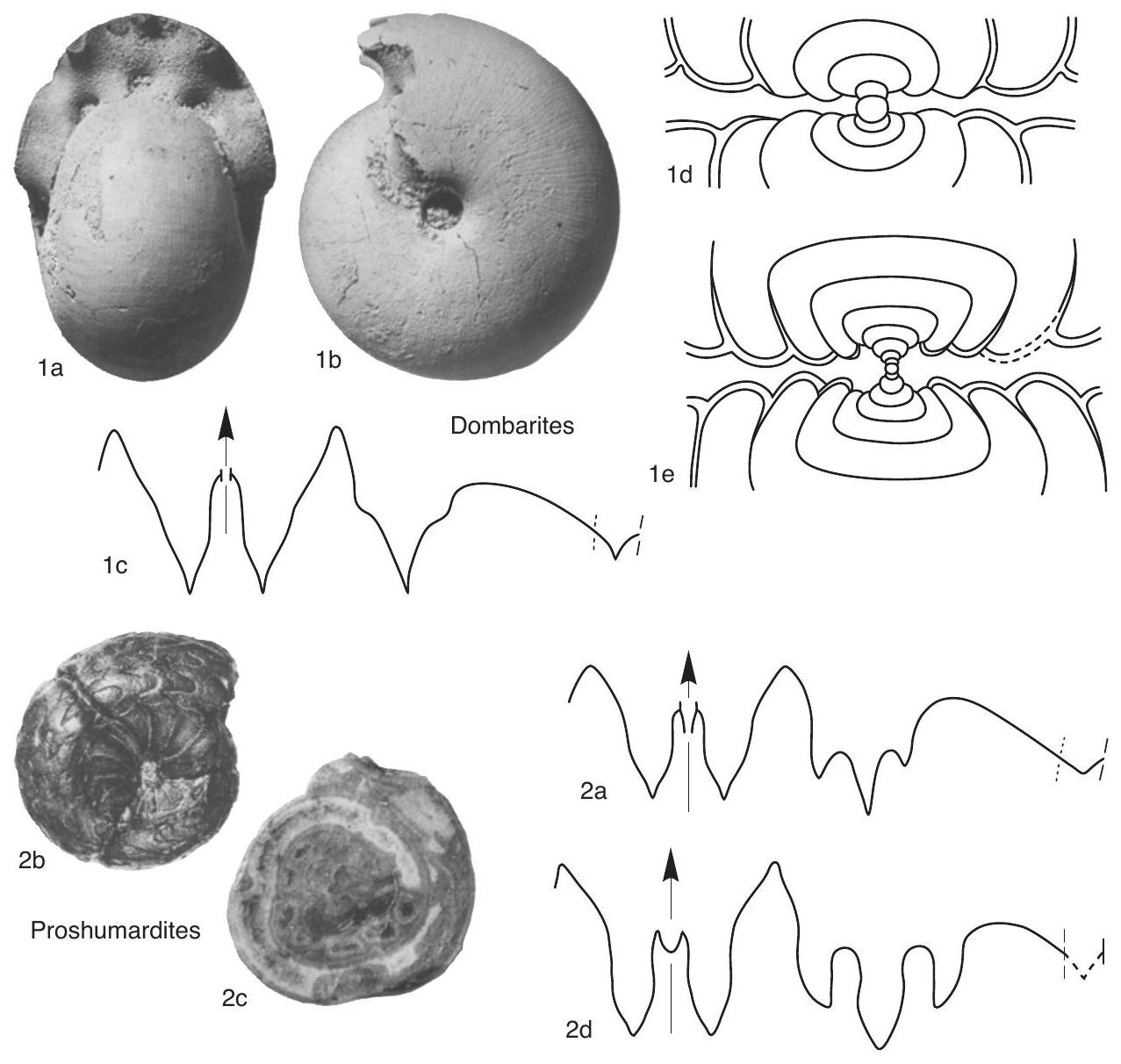Welcome to the Treatise on Invertebrate Paleontology!
Please enter a genera name to retrieve more information.

Proshumardites
Classification
Phylum:
Mollusca
Class:
Cephalopoda
Order:
Goniatitida
Superfamily:
Goniatitoidea
Family:
Delepinoceratidae
Formal Genus Name and Reference:
Proshumardites RAUZER-CHERNOUSOVA, 1928, p. 165
Type Species:
P. karpinskii, OD
Images
(Click to enlarge in a new window)
Fig. 35, 2a. *P. karpinskii, Chumaza River, South Urals, Bashkortostan, lower Bashkirian, Russia, whorl height at 8 mm , whorl width 10.5 mm , PIN 455/28786, X 4.3 (Ruzhentsev & Bogoslovskaia, 1978)., Fig. 35, 2b-d. P. delepinei (Schindewolf), b, Ben-Zireg, Algeria, Tagnana Formation, upper Serpukhovian, X 2 (Pareyn, 1961), c, median cut showing triangularity of inner whorls, DruzeticMilivojevici, upper Serpukhovian, Serbia, Collection Stevanovics Beograd, S 23, X 3, d, suture, Cantabrian Mountains, Perlora, Asturias, Spain, upper Serpukhovian, diameter at about 18 mm , GPIT 1206/258, X 2.4 (Kullmann, 1962).
Synonyms
Trigonoshumardites
Geographic Distribution
France, Spain, Serbia, Slovakia, Ukraine (Donets), Algeria, Iran, China (Gansu, Guangxi, Guizhou, Xinjiang), Japan, Russia (Novaia Zemlia, South Urals), Kazakhstan (South Urals, Tian Shan), Kyrgyzstan, Tajikistan (Darvaz, Hissar Mountains, Pamirs), Uzbekistan, Canada (Northwest Territories), USA (Arkansas, Oklahoma, Texas, Utah, Nevada.
Age Range
Beginning Stage in Treatise Usage:
Mississippian (Serpukhovian)
Beginning International Stage:
Serpukhovian
Fraction Up In Beginning Stage:
0
Beginning Date:
330.34
Ending Stage in Treatise Usage:
Pennsylvanian (Bashkirian, ?Moscovian)
Ending International Stage:
Moscovian
Fraction Up In Ending Stage:
100
Ending Date:
307.02
Description
Conch form thickly discoidal, umbilicus very narrow. Several species with triangular whorls on immature stages. Ornamentation consisting of fine growth lines and usually of prominent, closely spaced lirae, spiral ornamentation lacking in some species. Ventral lobe relatively wide, median saddle higher than half height of entire ventral lobe. Ventrolateral saddle rather broad, subacute, or narrowly rounded. Adventitious lobe wide and tridentate. More than ten species. [Trigonoshumardites had been erected for species with triangular inner whorls, a character regarded herein as being of specific significance. Several authors have assigned some species of Serpukhovian age to Pericleites; its type, Pericleites atticus Renz, had been secured from lower Permian (?Asselian) strata (see Renz, 1955, p. 413, 416), however; for discussion, see family Agathiceratidae herein (below).]
References
Museum or Author Information
Classification
Phylum:
Mollusca
Class:
Cephalopoda
Order:
Goniatitida
Superfamily:
Goniatitoidea
Family:
Delepinoceratidae
Formal Genus Name and Reference:
Proshumardites RAUZER-CHERNOUSOVA, 1928, p. 165
Type Species:
P. karpinskii, OD
Images
(Click to enlarge in a new window)
Fig. 35, 2a. *P. karpinskii, Chumaza River, South Urals, Bashkortostan, lower Bashkirian, Russia, whorl height at 8 mm , whorl width 10.5 mm , PIN 455/28786, X 4.3 (Ruzhentsev & Bogoslovskaia, 1978)., Fig. 35, 2b-d. P. delepinei (Schindewolf), b, Ben-Zireg, Algeria, Tagnana Formation, upper Serpukhovian, X 2 (Pareyn, 1961), c, median cut showing triangularity of inner whorls, DruzeticMilivojevici, upper Serpukhovian, Serbia, Collection Stevanovics Beograd, S 23, X 3, d, suture, Cantabrian Mountains, Perlora, Asturias, Spain, upper Serpukhovian, diameter at about 18 mm , GPIT 1206/258, X 2.4 (Kullmann, 1962).
Synonyms
Trigonoshumardites
Geographic Distribution
France, Spain, Serbia, Slovakia, Ukraine (Donets), Algeria, Iran, China (Gansu, Guangxi, Guizhou, Xinjiang), Japan, Russia (Novaia Zemlia, South Urals), Kazakhstan (South Urals, Tian Shan), Kyrgyzstan, Tajikistan (Darvaz, Hissar Mountains, Pamirs), Uzbekistan, Canada (Northwest Territories), USA (Arkansas, Oklahoma, Texas, Utah, Nevada.
Age Range
Beginning Stage in Treatise Usage:
Mississippian (Serpukhovian)
Beginning International Stage:
Serpukhovian
Fraction Up In Beginning Stage:
0
Beginning Date:
330.34
Ending Stage in Treatise Usage:
Pennsylvanian (Bashkirian, ?Moscovian)
Ending International Stage:
Moscovian
Fraction Up In Ending Stage:
100
Ending Date:
307.02
Description
Conch form thickly discoidal, umbilicus very narrow. Several species with triangular whorls on immature stages. Ornamentation consisting of fine growth lines and usually of prominent, closely spaced lirae, spiral ornamentation lacking in some species. Ventral lobe relatively wide, median saddle higher than half height of entire ventral lobe. Ventrolateral saddle rather broad, subacute, or narrowly rounded. Adventitious lobe wide and tridentate. More than ten species. [Trigonoshumardites had been erected for species with triangular inner whorls, a character regarded herein as being of specific significance. Several authors have assigned some species of Serpukhovian age to Pericleites; its type, Pericleites atticus Renz, had been secured from lower Permian (?Asselian) strata (see Renz, 1955, p. 413, 416), however; for discussion, see family Agathiceratidae herein (below).]
